
Wabash County is a county located in the U.S. state of Illinois. According to the 2010 census, it had a population of 11,947. Its county seat is Mount Carmel. It is located in the southern portion of Illinois known locally as "Little Egypt".

The Mount Pulaski Courthouse State Historic Site is a historic county courthouse located in Mount Pulaski, Illinois, United States. It was the county seat of Logan County from 1848 until 1855. It is one of only two remaining courthouses from Illinois's Eighth Circuit, the circuit on which central Illinois lawyer Abraham Lincoln carried out much of his practice of law. The courthouse is operated by the Illinois Historic Preservation Agency as a state historic site. Visitors are given guided tours of the recreated county offices and courtroom.

The Livingston County Courthouse is an historic building and a longtime judicial center for Livingston County, Illinois, United States. It is located in the county seat of Pontiac.
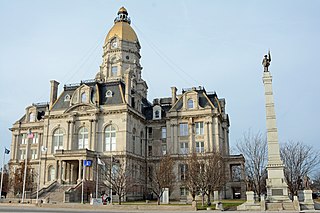
The Vigo County Courthouse is a courthouse in Terre Haute, Indiana. The seat of government for Vigo County, the courthouse was placed on the National Register of Historic Places in 1983.

Thomas Spottswood Hinde was an American newspaper editor, opponent of slavery, author, historian, real estate investor, Methodist minister and a founder of the city of Mount Carmel, Illinois. Members of the Hinde family were prominent in Virginia, Kentucky, Ohio, and Illinois. His sons Charles T. Hinde became a shipping magnate and Edmund C. Hinde an adventurer. He was the father-in-law of judge Charles H. Constable.
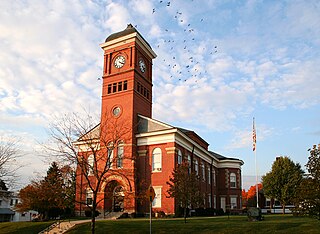
The Morrow County Courthouse is a historic government building in the village of Mount Gilead, Ohio, United States. Constructed in the middle of the nineteenth century, it has served as the county courthouse since Morrow County's earliest years, and it has been named a historic site.

The Wayne County Courthouse is a historic government building in Fairfield, Illinois, United States. Built to serve Wayne County in the 1890s, it replaced an older building whose capabilities were seen as inadequate.
Palmyra (1814–1821) was a town in the English Settlement, 2 miles (3.2 km) north of the town of Mount Carmel, Illinois, in what is today Wabash County. First settled in 1814, Palmyra was originally the site of a ferry across the Wabash River. Soon after the town was founded, a road was built between the settlement and the county line of Gallatin County, Illinois. It was named the first county seat of Edwards County, and meetings were held at the home of a resident. The peak population of the settlement was claimed to be between 500 and 600, though it is likely that these numbers are exaggerated. Epidemics of malaria and yellow fever killed a large portion of the settlement. By 1821, it was clear that the county seat had to be moved to a more stable town. On April 10, the Illinois General Assembly named Albion, Illinois the new seat.

The Pope County Courthouse is a government building in Golconda, the county seat of Pope County, Illinois, United States. The county's third courthouse, it has remained in operation since the early 1870s, making it one of Illinois' oldest buildings currently still used as a courthouse.

The Fayette County Courthouse is a government building in Vandalia, the county seat of Fayette County, Illinois, United States. Converted from a residence in the 1930s, it succeeded a former state capitol as the courthouse for Fayette County.

The Alexander County Courthouse is a government building in central Cairo, the county seat of Alexander County, Illinois, United States. Built in the 1960s, it is the latest in a series of courthouses erected in four towns across Alexander County.

The Calhoun County Courthouse is a government building in Hardin, the county seat of Calhoun County, Illinois, United States. Built in 1848 and expanded in the 20th century, it remains in use as the county's courthouse.

The Brown County Courthouse is a government building in Mount Sterling, the county seat of Brown County, Illinois, United States. Completed in 1868 and rebuilt around 1940, it is the second courthouse in the county's history.
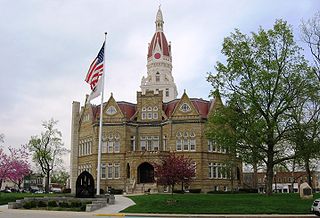
The Pike County Courthouse is a government building in Pittsfield, the county seat of Pike County, Illinois, United States. Completed in 1895, it is the fifth courthouse in the county's history.
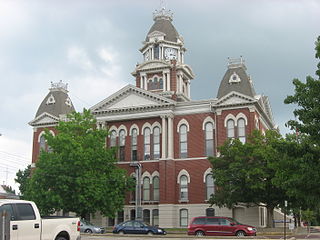
The Shelby County Courthouse is a government building in Shelbyville, the county seat of Shelby County, Illinois, United States. Completed in 1881, it is the third courthouse in the county's history.

The Clark County Courthouse is a government building in Marshall, the county seat of Clark County, Illinois, United States. Completed in 1903, it is the fifth courthouse in the third community in Clark County's history.

The St. Clair County Courthouse is a government building in Belleville, the county seat of St. Clair County, Illinois, United States. Built in 1976, it is the fifth courthouse in the history of the county, and one of two that still stands.

The Richland County Courthouse is a government building in Olney, the county seat of Richland County, Illinois, United States. Built in 1914, it is the fourth building to serve as the county's courthouse.
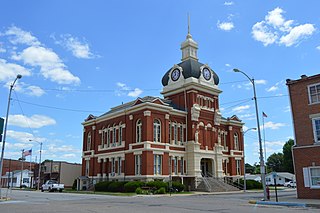
The Scott County Courthouse is a government building in Winchester, the county seat of Scott County, Illinois, United States. Completed in 1885, it is the third courthouse in the county's history.



















